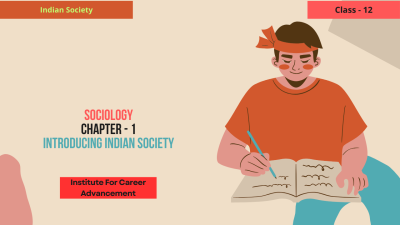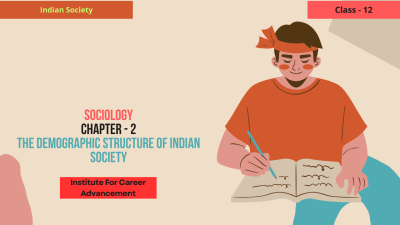Social Institutions: Continuity and Change - Class 12
Social institutions are established patterns of behavior that govern social relationships and interactions. They provide the framework for society and shape our lives in significant ways. This course explores the concept of social institutions, their role in society, and the factors that contribute to their continuity and change. Key Topics: Definition and Types of Social Institutions: Understanding the various types of social institutions, such as family, education, religion, economy, and politics. Functions of Social Institutions: Examining the roles played by social institutions in society, including socialization, regulation, and distribution of resources. Social Change: Analyzing the factors that lead to social change, such as technological advancements, economic development, and social movements. Continuity and Change in Social Institutions: Exploring how social institutions can remain stable over time while also adapting to changing social conditions. Case Studies: Examining specific examples of social institutions and their evolution, such as the family, education system, and religious organizations. Learning Objectives: Develop a comprehensive understanding of social institutions and their role in society. Analyze the factors that contribute to the continuity and change of social institutions. Evaluate the impact of social institutions on individuals and society. Develop critical thinking and problem-solving skills related to social issues. Appreciate the diversity and complexity of social institutions across different cultures and historical periods. Social Institutions: Continuity and Change is a valuable course that provides students with a deep understanding of the fundamental structures that shape our lives. It equips them with the knowledge and skills necessary to analyze social issues, evaluate societal change, and contribute to building a better future. সামাজিক প্রতিষ্ঠানগুলি আচরণের প্রতিষ্ঠিত নিদর্শন যা সামাজিক সম্পর্ক এবং মিথস্ক্রিয়া পরিচালনা করে। এগুলি সমাজের জন্য কাঠামো সরবরাহ করে এবং আমাদের জীবনকে উল্লেখযোগ্য উপায়ে রূপ দেয়। এই কোর্সটি সামাজিক প্রতিষ্ঠানের ধারণা, সমাজে তাদের ভূমিকা এবং তাদের ধারাবাহিকতা ও পরিবর্তনে অবদান রাখার কারণগুলি অন্বেষণ করে। মূল বিষয়ঃ সামাজিক প্রতিষ্ঠানের সংজ্ঞা ও প্রকারঃ পরিবার, শিক্ষা, ধর্ম, অর্থনীতি এবং রাজনীতির মতো বিভিন্ন ধরনের সামাজিক প্রতিষ্ঠানকে বোঝা। সামাজিক প্রতিষ্ঠানের কার্যাবলীঃ সমাজে সামাজিক প্রতিষ্ঠানের ভূমিকা পরীক্ষা করা, যার মধ্যে সামাজিকীকরণ, নিয়ন্ত্রণ এবং সম্পদের বন্টন অন্তর্ভুক্ত। সামাজিক পরিবর্তনঃ প্রযুক্তিগত অগ্রগতি, অর্থনৈতিক উন্নয়ন এবং সামাজিক আন্দোলনের মতো সামাজিক পরিবর্তনের দিকে পরিচালিত করে এমন কারণগুলি বিশ্লেষণ করা। সামাজিক প্রতিষ্ঠানগুলির ধারাবাহিকতা ও পরিবর্তনঃ পরিবর্তিত সামাজিক অবস্থার সঙ্গে খাপ খাইয়ে নেওয়ার পাশাপাশি সামাজিক প্রতিষ্ঠানগুলি কীভাবে সময়ের সাথে স্থিতিশীল থাকতে পারে তা অন্বেষণ করা। কেস স্টাডিঃ পরিবার, শিক্ষা ব্যবস্থা এবং ধর্মীয় সংগঠনের মতো সামাজিক প্রতিষ্ঠান এবং তাদের বিবর্তনের নির্দিষ্ট উদাহরণগুলি পরীক্ষা করা। শেখার উদ্দেশ্যঃ সামাজিক প্রতিষ্ঠান এবং সমাজে তাদের ভূমিকা সম্পর্কে একটি ব্যাপক বোঝাপড়া গড়ে তোলা। সামাজিক প্রতিষ্ঠানের ধারাবাহিকতা ও পরিবর্তনে অবদান রাখার কারণগুলি বিশ্লেষণ করুন। ব্যক্তি ও সমাজের উপর সামাজিক প্রতিষ্ঠানের প্রভাব মূল্যায়ন করা। সামাজিক সমস্যা সম্পর্কিত সমালোচনামূলক চিন্তাভাবনা এবং সমস্যা সমাধানের দক্ষতা বিকাশ করুন। বিভিন্ন সংস্কৃতি ও ঐতিহাসিক সময়কালে সামাজিক প্রতিষ্ঠানের বৈচিত্র্য ও জটিলতার প্রশংসা করুন। সামাজিক প্রতিষ্ঠানঃ ধারাবাহিকতা এবং পরিবর্তন একটি মূল্যবান কোর্স যা শিক্ষার্থীদের আমাদের জীবনকে রূপদানকারী মৌলিক কাঠামো সম্পর্কে গভীর ধারণা প্রদান করে। এটি তাদের সামাজিক সমস্যাগুলি বিশ্লেষণ, সামাজিক পরিবর্তনের মূল্যায়ন এবং একটি উন্নত ভবিষ্যত গঠনে অবদান রাখার জন্য প্রয়োজনীয় জ্ঞান ও দক্ষতার সাথে সজ্জিত করে।
English
Last updated
Wed, 27-Nov-2024



















